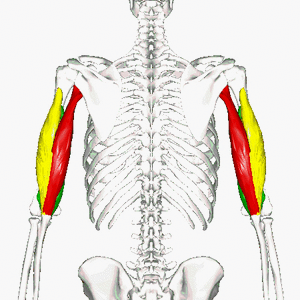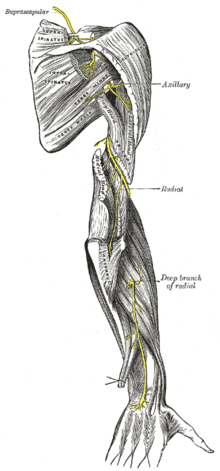Triceps brachii: Difference between revisions
No edit summary |
No edit summary |
||
| Line 17: | Line 17: | ||
* Origin: infraglenoid tubercle of the [[scapula]] | * Origin: infraglenoid tubercle of the [[scapula]] | ||
* Insertion: Posterior surface of the olecranon process of the [[ulna]], capsule of the [[elbow]] joint and antebrachial fascia. | * Insertion: Posterior surface of the olecranon process of the [[ulna]], capsule of the [[elbow]] joint and antebrachial fascia. | ||
* Action: extension of the forearm | * Action: Because it attaches to the scapula, the long head not only extends the elbow but will also have a small action on the [[Glenohumeral Joint|glenohumeral]] joint. With the arm adducted, the triceps muscle acts to hold the head of the humerus in the glenoid cavity. This action helps prevent any displacement of the humerus. The long head also assists with the extension and adduction of the arm at the shoulder joint. The lateral head is also active during extension of the forearm at the elbow joint when the forearm is supinated or pronated. | ||
* Innervation: [[radial nerve]] | * Innervation: [[radial nerve]] | ||
| Line 24: | Line 24: | ||
* Origin: posterior aspect of the [[humerus]], superior to the radial groove | * Origin: posterior aspect of the [[humerus]], superior to the radial groove | ||
* Insertion: Posterior surface of the olecranon process of the ulna, capsule of the elbow joint and antebrachial fascia. | * Insertion: Posterior surface of the olecranon process of the ulna, capsule of the elbow joint and antebrachial fascia. | ||
* Action: extension of the forearm | * Action: This head is considered to be the strongest head of the three. It is active during extension of the forearm at the elbow joint when the forearm is supinated or pronated. | ||
* Innervation: radial nerve | * Innervation: radial nerve | ||
| Line 31: | Line 31: | ||
* Origin: posterior aspect of humerus, inferior to the radial groove | * Origin: posterior aspect of humerus, inferior to the radial groove | ||
* Insertion: Posterior surface of the olecranon process of the ulna, capsule of the elbow joint and antebrachial fascia. | * Insertion: Posterior surface of the olecranon process of the ulna, capsule of the elbow joint and antebrachial fascia. | ||
* Action: extension of the forearm | * Action: As the medial head does not attach to the scapula and therefore has no action on the glenohumeral joint, whether with stabilization or movement. However, the medial head is active during extension of the forearm at the elbow joint when the forearm is supinated or pronated. | ||
* Innervation: radial nerve<ref name=":0" /> | * Innervation: radial nerve<ref name=":0" /> | ||
Revision as of 02:00, 30 December 2021
forOriginal Editor - Esraa Mohamed Abdullzaher
Top Contributors - Mandeepa Kumawat, Esraa Mohamed Abdullzaher, Lucinda hampton, Joao Costa, Kim Jackson, Sai Kripa, Nikhil Benhur Abburi, WikiSysop and Kirenga Bamurange Liliane
Description[edit | edit source]
The triceps brachii is a large, thick muscle on the dorsal part of the upper arm. It often appears as the shape of a horseshoe on the posterior aspect of the arm. The main function of the triceps is the extension of the elbow joint.[1]
The Triceps brachii gets its name with tri referring to "three" muscle heads or points of origin (with Brachii referring to the arm). These include the: Medial head; Lateral head; Long head
Image 1: Triceps brachii muscle: Long head red; Lateral head yellow; Medial head green
Triceps brachii -Muscles[edit | edit source]
Long head
- Origin: infraglenoid tubercle of the scapula
- Insertion: Posterior surface of the olecranon process of the ulna, capsule of the elbow joint and antebrachial fascia.
- Action: Because it attaches to the scapula, the long head not only extends the elbow but will also have a small action on the glenohumeral joint. With the arm adducted, the triceps muscle acts to hold the head of the humerus in the glenoid cavity. This action helps prevent any displacement of the humerus. The long head also assists with the extension and adduction of the arm at the shoulder joint. The lateral head is also active during extension of the forearm at the elbow joint when the forearm is supinated or pronated.
- Innervation: radial nerve
Lateral head
- Origin: posterior aspect of the humerus, superior to the radial groove
- Insertion: Posterior surface of the olecranon process of the ulna, capsule of the elbow joint and antebrachial fascia.
- Action: This head is considered to be the strongest head of the three. It is active during extension of the forearm at the elbow joint when the forearm is supinated or pronated.
- Innervation: radial nerve
Medial head
- Origin: posterior aspect of humerus, inferior to the radial groove
- Insertion: Posterior surface of the olecranon process of the ulna, capsule of the elbow joint and antebrachial fascia.
- Action: As the medial head does not attach to the scapula and therefore has no action on the glenohumeral joint, whether with stabilization or movement. However, the medial head is active during extension of the forearm at the elbow joint when the forearm is supinated or pronated.
- Innervation: radial nerve[1]
Nerve[edit | edit source]
All the three heads of triceps brachii are innervated by the four branches of the radial nerve (C7, C8). However, according to the cadaveric study it is found that the medial head of triceps brachii is innervated by the ulnar nerve.[2]. Some research reveals that the long head of triceps is actually innervated by the axillary nerve.[3]
Image 2: Radial nerve
Artery[edit | edit source]
The muscle is supplied with oxygen and nutrients from the branches of the deep brachial artery.[4]
Function[edit | edit source]
- It helps in extension of the elbow joint and also acts as an antagonist of the biceps and brachialis.
- The triceps brachii also helps to stabilize the shoulder by keeping the head of the humerus in its correct position in the shoulder joint.
- Muscle histology and average innervation ratios estimated from absolute mononeurons (MN) counts shows that the lateral head is used for movements requiring occasional high-intensity force, while the medial head enables more precise, low-force movements.
- medial head was predominantly formed by small type I fibers and motor units (69 fibers/MN).
- the lateral head comprised a great quantity of large type IIb fibers and motor units (179 fibers/MN)
- the long head consisted of a more balanced mixture of fiber types and motor units (99 fibers/MN).[5]
- When the shoulder is internally rotated, the ability of the long head of the triceps brachii to extend and adduct the shoulder is diminished. The shoulder must be externally rotated in order for the long head of the triceps brachii to assist shoulder adduction.[6]
Video[edit | edit source]
Assessment[edit | edit source]
Palpation[edit | edit source]
Palpating the three heads of the triceps includes:
Position of the patient: High sitting position
Position of the therapist: Behind the patient
Palpation of medial head- Firstly, use a landmark to palpate the muscle. In this case, the landmark would be medial epicondyle of the humerus. The examiner will place his/her three fingers just above the medial epicondyle and instruct the patient to extend the elbow pushing downward force on the couch as if to lift himself or herself up. Finally palpate the medial head.
Palpation of long head- Palpate from medial condyle of the humerus up to the axilla posteriorly would be the area for long head of triceps. Just beneath the axilla posteriorly, the examiner will place his/her three fingers & instruct the patient to extend the elbow pushing downward. Finally, palpate the long head of the triceps.
Palpation of lateral head- In order to palpate for the lateral head, place three fingers to the postero-lateral side in the middle of the shaft of the humerus & instruct the patient to extend the elbow.
Anconeus- To palpate the anconeus, the landmark would be lateral condyle of the humerus to the proximal ulna & instruct the patient to extend the elbow.
Length test[edit | edit source]
Treatment[edit | edit source]
Strengthening[edit | edit source]
Stretching[edit | edit source]
Myofascial release technique[edit | edit source]
References[edit | edit source]
- ↑ 1.0 1.1 Tiwana MS, Sinkler MA, Bordoni B. Anatomy, Shoulder and Upper Limb, Triceps Muscle.Available:https://www.statpearls.com/articlelibrary/viewarticle/30580/ (accessed 30.12.2021)
- ↑ Bekler H, Wolfe VM, Rosenwasser MP. A cadaveric study of ulnar nerve innervation of the medial head of triceps brachii. Clinical orthopaedics and related research. 2009 Jan 1;467(1):235-8.
- ↑ Triceps Brachii: Functional Anatomy Guide-The Definitive Guide to Triceps Brachii Anatomy, Exercises & Rehabwww.kingofthegym.com/triceps-brachii/(accessed 12 June 2018)
- ↑ Triceps Anatomy, Origin & Function | Body Mapswww.healthline.com/human-body-maps/triceps#1(accessed 13 June 2018)
- ↑ Lucas‐Osma AM, Collazos‐Castro JE. Compartmentalization in the triceps brachii motoneuron nucleus and its relation to muscle architecture. Journal of Comparative Neurology. 2009 Sep 20;516(3):226-39.
- ↑ ExRx.net : Triceps Brachii https://www.exrx.net/Muscles/TricepsBrachii (accessed 20 June 2018)








